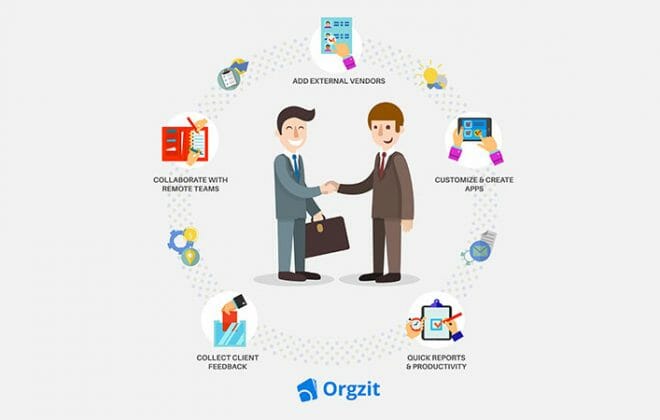Step-by-Step Guide for Effective Clients Onboarding
“The key is to set realistic customer expectations, and then not to just meet them, but to exceed them, preferably in unexpected and helpful ways”
–Richard Branson
Founder of Virgin Group
Names added to the list. Late-night meetings. Last-minute edits. Final Approvals.
And there you have- With Your brand new client!!
It doesn’t matter whether you’re into consultancy, accounting practice, digital agency, or any client-focused business- The client onboarding process is extremely vital everywhere.
From sales to the service handoff process, it is essential to know what can make or break your client journey.
As per US News & World Report, 82% of the clients move from one business to another because of poor client services, and it all begins with how they are onboard.
Client servicing isn’t just about bringing them on the table but retaining them for a long-term connection. According to Harvard Business Review reports, if you can prevent 5% of your customers from leaving, you can lift the bottom profile line by 25-95%.
Today, I will cover every nook and cranny of onboarding clients efficiently, plus provide actionable insights with relevant examples.
So, without further add-ons, let’s begin!!
What is Client Onboarding?
Client onboarding is the process of welcoming new clients into your organization, addressing their concerns, and ensuring the best quality services. Client onboarding is one of the essential functions of any organization as it directly affects the customer journey and thereby profits.
15 Best Tips for Onboarding Clients Efficiently
1. Welcome them on a Personal Note
The title is pretty self-explanatory, so let’s try perceiving the situation from a different angle. Take, for example, you’re one of the service-based companies in the market, and you have got the client listed in your papers. Now what?
How do you stay in the good books of clients? What exactly does it take to stand out?
What persuades the client to stay hooked with your organization?
So, the easy response would be – Make them feel welcome right from the start.
Personalize their experience, go over the top, do a little show-off, start the bond with a bang!!
Welcome Emails and Welcome Videos are two simple yet popular methods of wowing the clients.
As per the client’s preferences, tailored emails could be one fantastic way to begin a happy engagement.
However, as per studies, 54% of the consumers vote for the video content. A welcome video should demonstrate important information about the organization, introduce team members, enlighten company values, and, yes, exhibit a lot of excitement.
Although we agree that creating personalized videos can be time-consuming, especially when compared with welcoming emails.
So, whatever be your way, while interacting with your newly signed client, make sure that the first foot is set right.
2. Get to know your Client Better
You must have done the homework on your client before signing them. However, the chapter doesn’t end here; as time passes, try digging into your client’s persona, their history. Check out their previous experiences.
How many projects succeeded, and how many failed? What made those relationships sour? Take your time and collect all the relevant data. Check out their social handles to garner knowledge for better decision-making.
3. Assess your Client Needs & Develop an Outline
One essential step of the onboarding process is the assessment of the client’s requirements. Every client is different, and so their expectations with the project. Enlist your client’s current needs and figure out the areas of improvement.
After you have understood the client’s persona, develop a goal that your team can act on. The more clearly you articulate the goals, the easier it would be for everyone to stay on track. After you have outlined the desired goals, review this with your client to ensure everyone is on the same page.
For example, the client wants to get designed a pet management platform. Before you embark on the journey, make sure that you have listed the features and functionalities and share them with the client for review.
4. Pick the best People for Job
The requirements gathering stage has been crossed, and now it’s time to gather experts for giving this imagination into reality. The key here is to understand what kind of team would make the job easier and meet client expectations.
Research shows that a team that can strike a personal chord with a client is more likely to be the best choice. A mixture of skills and cultural fit will result in a smoother onboarding process. A good project management team consists of a project manager, analyst, designer, developer, tester, and marketing specialist.
5. Hold an Internal Meeting
Before having the first “official project discussing meeting” with the team and clients, you should consider educating your team about the client (industry, services/ products, work scope, etc.). The goal here is to explain to the team about the client’s vision thoroughly and ready them for the prep work-
- Bring everything under sheets- assessment, contract, meetings notes as a primary handover package.
- Ask your team to check out the client’s social media handles and meeting notes.
- Provide them with reading material, such as blog posts related to projects, etc.
6. Set Clear Expectations
This is one of the most crucial steps in the onboarding clients checklist. Make sure that your clients know the probable outcomes and are not expecting something out of the blue.
The best way to accomplish this is by stating your requirements, sending them for review, and then having a quick questionnaire consisting of discussed outcomes. When the client records the responses, you can use them later in the journey as evidence for denying anything irrelevant.
Also Read, 7 Techniques to close deals faster.
7. Be Ready for the Kick-Off Call
Once everybody is on the same page- it’s time for the kick-off call. It is the first crucial meeting for client engagement. This call sets the foundation for the rest of your journey.
Use this to set expectations, discuss working relationships, ask any lingering questions for the process, etc. This way, your team can put their best foot forward and have understood the client better.
8. Keep reminding your value proposition for the client
It is essential that your planning and actions align with the client’s expectations. Even though you are communicating to a single person, you are talking to an organization or, really, an individual who has a family, a full-time job, and a lot much behind the curtains.
Hence it is essential to understand their persona and remind them of your commitments, which is often called verbal contracts, to confirm that both the parties are on a similar page.
Remind them that your company is extremely useful and sensitive to clients’ needs and take care of every little detail for onboarding clients efficiently. Express how the efficient onboarding system would save their money and time that is spent on redundant tasks.
9. Train Your Clients
The next step of client onboarding is training. As we’ve already mentioned, training begins with the first onboarding call and shall continue throughout the engagement.
During this stage, it is crucial to understand their learning style. How do they like to operate? Do they prefer email communication or video conferences? Do they like weekly calls, or are they okay with once-in-a-month meetings?
Either way, you have to teach your clients about your company’s working methodology. Teach them whatever few critical tools you are using for managing projects to ensure smooth operations.
For instance, if your company uses Trello or Orgzit for project management, make sure you have given the client initial demos on how to use the software, check tasks, etc.
Schedule dedicated training sessions as per the client’s availability. The training need not be like a formal classroom course; it can be a pdf document, short video, a step-by-step guide sent through the mail, etc.
10. Give a Smooth Handoff at every stage
To understand the relevancy of this step, let’s take an example that is quite common. Assume you’re leading a team in a service-based company, and one of your developers has left the organization leaving the project in the middle.
You can either repeat all the steps mentioned above or create a handoff detailing every bit of information required. A smooth handoff would enlist-
- A brief introduction of who the person is
- Definition of their roles and responsibilities
- What all details clients need to know about this person
- And how exactly the two parties would be working.
Companies need to pass the handoff for every subsequent person that steps into the scene. This way, everybody would be on the same page.
11. Keep Communication Consistent
Communication is the lifeblood of any project, and it is the key to any healthy relationship.
Have an effective communication process that entails the following components-
- Common Point of Contact
- Communication Schedule
- Detailed Summary
- A proper communication tool
After the initials are done, inform the client of a common point of contact. This person is usually the team lead, strategist, or project manager, depending on the engagement. Share the person’s contact information like their email address, skype id, role, etc.
While deciding the communication schedule, identify both the team’s availability and the client for consistent communication.
Once the call is done, create a detailed summary and share it with clients and the team.
Lastly, to conduct smooth interactions, avail proper communication tools. For example, slack can be used for day-to-day chats with clients, and zoom can be used for conducting meetings.
12. Outline the technology & tools to be used in the project
The client must be aware of all the tools and technologies utilized during project development. Let’s suppose your team uses React Native and Javascript for developing apps; Ahref, google analytics for marketing campaigns. Ensure detailing your client about all these technologies for an effective onboarding experience.
13. Don’t make the client repeat themselves
Like who loves to repeat in the first place? The point here is if the client mentioned some pointers during the sales process, then they shouldn’t have to repeat it. Hence, create a reliable system to transfer the information.
One way was to pass handoffs whenever somebody new steps in. However, the team may get stuck on a particular stage due to confusion or something else. To solve this problem, you can use CRM and perform the following steps-
- Document the contract and update it from time-to-time.
- Create detailed notes after calls and share them with the team for future usage.
Check out- Best Practices for your Vendor Management Workflows.
14. Don’t forget to take feedback from the clients
Your clients are the ones that use your services or products regularly, and hence they are your first-hand feedback givers. Make them heard. Be an organization that is known for its caring and listening characteristics.
A fulfilled client is more likely to look for a solution during some roadblocks rather than jumping boats.
Discuss ideas and suggestions with them. If your client points out some loophole, then make sure to shed sometime in their pointed direction. Try behaving like a responsible partner for the effective onboarding of customers.
15. Get your Hands Dirty in Pit
Congrats on making it this far!!
However, this represents that you’re not only here for tips and tricks but to actually change the game, which can’t happen without a little action.
Gear up and get the work done. Be realistic about the client’s requirements, and know what is feasible. Find out what the client needs. Do they want to migrate data between systems? Do they care about those extra bells and buttons? Work accordingly.
Conclusively, the success of your project depends upon what’s done and not only what’s planned!!!!
Boost ROI with an efficient CRM and Project management system
Effective onboarding of customers is a journey, and to make the most out of engagement, one needs to have an eye for detail. If not treated right, the poorly onboarded customers would not leave the room but spread a bad mouth, which is a big No-No!!
“It takes 20 years to build a reputation and five minutes to ruin it.”- Warren Buffett
Therefore we need a solution here for onboarding clients efficiently and increasing the retention rate. This is where Orgzit, a full-fledged CRM and Project Management system, does the wonders. Work automation, improvised relationships between stakeholders, and updated charts are a few of the highlights!!
Don’t believe us? Check out yourself.
Liked what you read? Feel free to drop suggestions in the comment box below.
Happy Onboarding!









